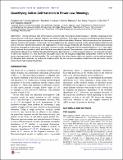Quantifying Cell-to-Cell Variation in Power-Law Rheology
Author(s)
Cai, PingGen; Mizutani, Yusuke; Tsuchiya, Masahiro; Maloney, John M.; Fabry, Ben; Van Vliet, Krystyn J.; Okajima, Takaharu; Maloney, John M.; Van Vliet, Krystyn J.; ... Show more Show less
DownloadVan Vliet_Quantifying cell.pdf (967.0Kb)
PUBLISHER_CC
Publisher with Creative Commons License
Creative Commons Attribution
Terms of use
Metadata
Show full item recordAbstract
Among individual cells of the same source and type, the complex shear modulus G[subscript ∗] exhibits a large log-normal distribution that is the result of spatial, temporal, and intrinsic variations. Such large distributions complicate the statistical evaluation of pharmacological treatments and the comparison of different cell states. However, little is known about the characteristic features of cell-to-cell variation. In this study, we investigated how this variation depends on the spatial location within the cell and on the actin filament cytoskeleton, the organization of which strongly influences cell mechanics. By mechanically probing fibroblasts arranged on a microarray, via atomic force microscopy, we observed that the standard deviation σ of G[subscript ∗] was significantly reduced among cells in which actin filaments were depolymerized. The parameter σ also exhibited a subcellular spatial dependence. Based on our findings regarding the frequency dependence of σ of the storage modulus G[subscript ′], we proposed two types of cell-to-cell variation in G[subscript ′] that arise from the purely elastic and the frequency-dependent components in terms of the soft glassy rheology model of cell deformability. We concluded that the latter inherent cell-to-cell variation can be reduced greatly by disrupting actin networks, by probing at locations within the cell nucleus boundaries distant from the cell center, and by measuring at high loading frequencies.
Date issued
2013-09Department
Massachusetts Institute of Technology. Department of Biological Engineering; Massachusetts Institute of Technology. Department of Materials Science and EngineeringJournal
Biophysical Journal
Publisher
Elsevier
Citation
Cai, PingGen, Yusuke Mizutani, Masahiro Tsuchiya, John M. Maloney, Ben Fabry, Krystyn J. Van Vliet, and Takaharu Okajima. “Quantifying Cell-to-Cell Variation in Power-Law Rheology.” Biophysical Journal 105, no. 5 (September 2013): 1093–1102. © 2013 Biophysical Society
Version: Final published version
ISSN
00063495
1542-0086